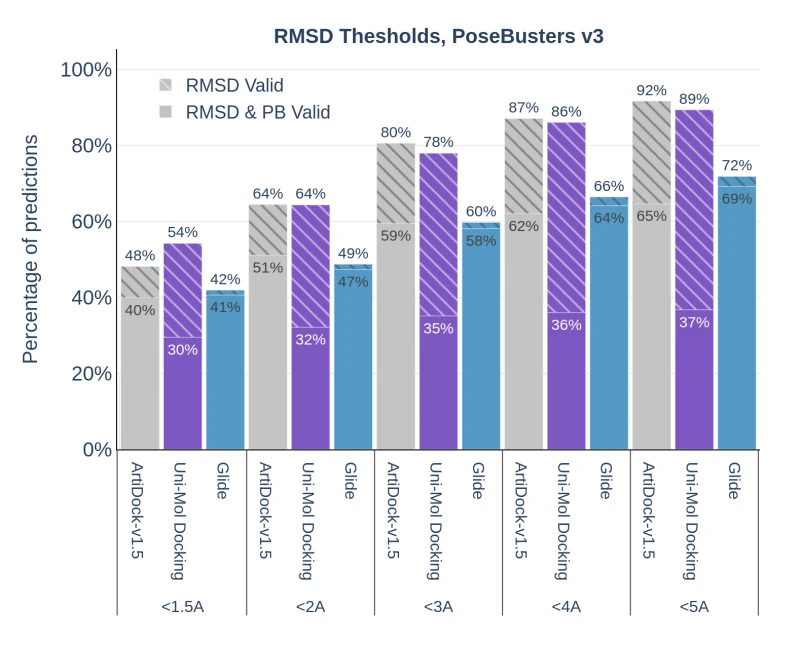Busting the PoseBusters v3: AI Docking Software ArtiDock Beats Industry’s State of the Art in Speed and Accuracy
We at Receptor.AI are excited to present the next important milestone in the development of our next-generation AI docking model, ArtiDock v1.5. This version contains a carefully tuned architecture and numerous optimizations of the model training and inference, which allowed us to significantly improve an already impressive performance metric.
ArtiDock v1.5 will soon be available for everybody on Nvidia BioNeMo, the groundbreaking drug discovery cloud service from the technological giant. Receptor.AI was recently featured as a Nvidia partner at the prestigious J.P. Morgan conference alongside innovations from DeepMind and MIT for notable contributions in drug discovery, which gives us a strong motivation for further development.
ArtiDock v1.5, an advanced feature of the Receptor.AI platform, has been fully integrated into various specialized drug discovery workflows. This integration marks a significant breakthrough, particularly in the realm of protein-protein interactions related to immuno-oncology targets. Historically, these targets were addressed solely through antibody-based approaches. However, with ArtiDock v1.5, we've successfully identified several high-quality hit compounds for three of these challenging targets. Our team is now focused on the next critical phase of refining these small molecules into optimized lead compounds.
Moreover, the release of ArtiDock v1.5 coincided with an important development in the AI docking field: the peer-reviewed publication of the PoseBusters v3 dataset. PoseBusters is intended to challenge the AI ligand pose prediction techniques by introducing an extensive set of structural metrics that should be used in parallel with the plain old RMSD to assess the quality of docked ligands.
First, we compared the performance of the previous version of ArtiDock v1.0 and the current ArtiDock v1.5 with a number of other techniques on either PoseBusters v1.0 or the latest PoseBusters v3 datasets (Figure 1).


It is clearly seen that the new version of PoseBusters favors conventional docking programs while penalizing DiffDock and earlier docking techniques such as TankBind and EquiBind. However, modern techniques like ArtiDock and Uni-Mol Docking perform better on PoseBusters v3. The improvement between ArtiDock v1.0 and ArtiDock v1.5 is consistent and reaches ~3%.
ArtiDock is the best-performing AI docking technique among all tested if the PoseBusters set of structural metrics is considered. Its performance is by a large margin better than that of its next rival, Uni-Mol Docking, and even better than the results of the most reputable industry-standard docking program, Glide, which performs surprisingly well in the PoseBusters test.
Next, we studied the influence of the RMSD cutoff on the performance of ArtiDock v1.5 and two of its most relevant rivals, Uni-Mol Docking and Glide. We considered RMSD cutoffs from 1.5A to 5A and analyzed the PoseBusters v3 scores of these three techniques.

For the tightest cutoffs, <1.5A ArtiDock v1.5 performs on par or even better than Glide, while Uni-Mol Docking falls more and more behind. PoseBusters structural metrics of Glide and ArtiDock progressively improve with the increase in RMSD cutoff, while the metrics of Uni-Mol Docking do not.
This observation shows the importance of performing comprehensive comparisons that are not limited to a single RMSD cut-off value, which could be mistakenly interpreted as the only ultimate quality predictor. It is easy to draw a biased conclusion at RMSD<2A while the wider cutoff of RMSD<5A provides much more consistent results.
The last, but not least, is the inference time of ArtiDock, which is the best among all deep learning models with good PoseBusters metrics. The inference speed of ArtiDock is comparable to that of Uni-Mol and TankBind while being far superior to them in terms of accuracy. ArtiDock 1.5 is one order of magnitude faster than Glide and two orders of magnitude faster than Vina and Gold, which makes it preferable for high-throughput screening applications.
Contact the team at Receptor.AI to learn more and explore partnership opportunities.